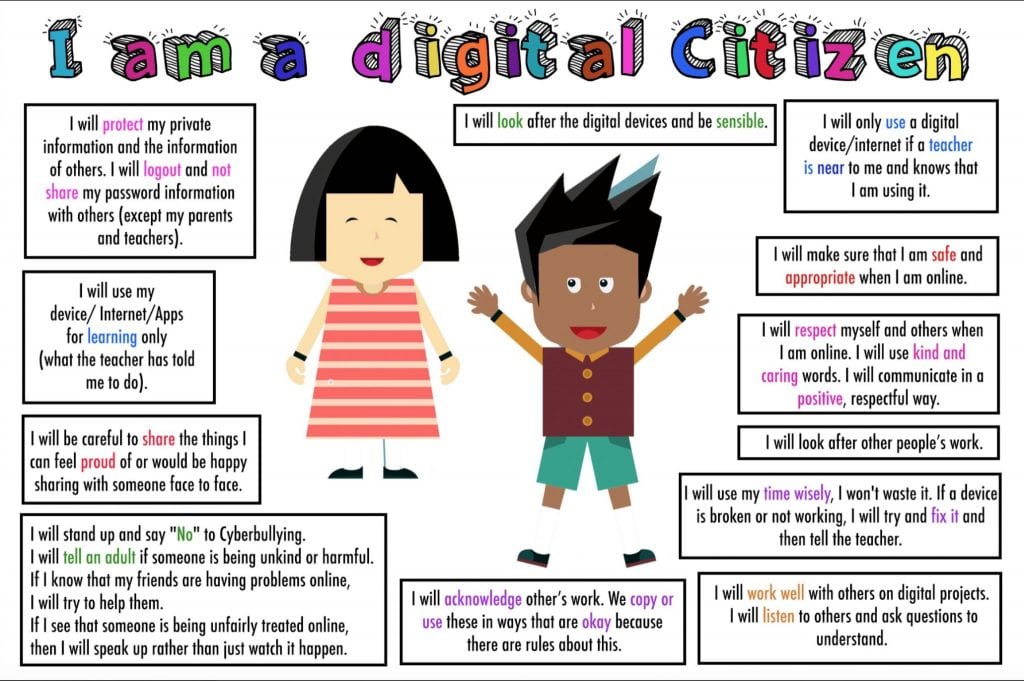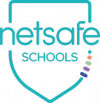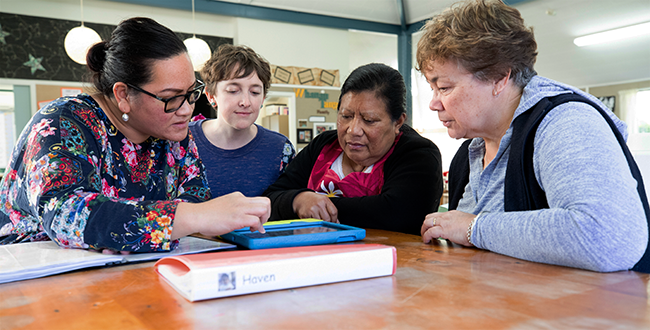Digital citizenship and online safety in the community
How does your school engage with your community to plan and respond to the impact of technologies, particularly digital citizenship and online safety?
Learning involves a three-way partnership between the learner, their whānau, and the school or kura. Starting with the aspirations of the learner and their whānau, each partner has a part to play to ensure that learning with digital technologies is effective and safe for ākonga. Habits and techniques learned at school and home can set the tone for future use of digital technologies once students leave school.
Community engagement is one of the principles of NZC. The "school community" is a term variously used to mean staff, students, parents/whānau, other people connected with the school, people living in the area, or any combination of these.
– Implementation of the New Zealand Curriculum: Synthesis of research and evaluation, 2011
Foundations for successful community engagement
Digital citizenship is an aspect of digital fluency. Involving whānau in developing your digital fluency strategy means you have the support at home to reinforce what is happening at school. Engagement with your community about learning with digital technologies should be underpinned by the following:
- a desire for genuine dialogue and conversation with whānau
- Understanding of local needs, trends and aspirations in regards to digital citizenship
- clarity about the links between learning with digital technologies and how it supports the school or kura’s vision
- up-to-date knowledge of how digital technologies enhance teaching and learning
- current knowledge of the actual risks represented by various digital technologies and the steps to mitigate the risks
- use of a variety of communication channels to reduce barriers to engagement and to ensure inclusiveness
- being well-informed by data, research, and best practice evidence
- maintaining up-to-date digital citizenship documentation, such as policies and responsible use agreements
- ensuring documentation reflects the values and vision of your school or kura, and your community.
When we use digital technologies and online spaces it’s important that we learn ways to keep ourselves safe, and that we make positive choices in ways we behave when we are online. At our school we call this being a "digital citizen" and good digital citizens help to make our school a safe and positive place for everyone.
Talk with parents, whānau, and students
There are many ways to initiate dialogue with parents and whānau about online safety and digital citizenship, including:
- newsletters
- school website
- notices/emails home
- social media (which provides a "many to many" communication channel)
- Community meetings and/or round table working parties
- a student user agreement, to be discussed and signed by students and whānau.
What’s important, is to turn that initial contact into a three-way dialogue involving the school, whānau, and the students.
A student user agreement should not be used as a "set and forget" safety tool. Schools are encouraged to promote and reinforce responsibilities and expectations through regular student and community communications.
Your school will already have policy in place, and alongside talking to ākonga, needs to:
- find out what parents know/understand about responsible use
- introduce/socialise the school policy and responsible use agreements and provide parents time to input into those when policy is reviewed annually
- find out what parents and caregivers believe are needs or issues for their children
- work with parents to identify and discuss issues with social media e.g. cyberbullying in and out of school, posting inappropriate images and videos
- make parents aware of any filtering available to them through school eg. N4L during lockdown
- introduce whānau to some of the resources available to keep their childrens’ online activity safe at home.
Ways to engage with your school whānau
Digital citizenship evening/afternoon
Include a way for parents who are unable to physically attend the meeting to catch up. One possibility is to use video conferencing software so people can join from anywhere, and to record the meeting and make it available afterwards. Also include a way for parents who couldn’t attend to have their questions answered.
Check-in with parents at 3-way conferences
A benefit of using 3-way conferences is that their child is also present. It’s a good opportunity for discussion about expectations and behaviour online. Some important aspects are:
- Responsibilities – who is responsible for what, where and when
- Behaviours – in school and out of school
Send tips home via newsletter, website, Facebook
Provide an opportunity for parents to ask questions. Seek permission to publish the most pertinent questions and answers for everyone in the school community, perhaps in a regular section of the school newsletter.
Community meetings are one way to communicate with whānau and the community, as part of an ongoing dialogue.
The dialogue process may require multiple events. Consider holding events at different times of day and in different locations such as your local marae or church hall, depending on the needs of your community.
Netsafe have provided a presentation for parents that can be adapted to your needs.
Initial meeting
A key purpose of this meeting is to help whānau to understand the "why" of learning with digital technologies. It is important that there are continued positive partnerships for the benefit of all learners.
Prior to the meeting, gather information from parents to find out their understanding, concerns, priorities. Use a survey/questionnaire, providing both online and paper-based options, or set up a question/comment box at school
An initial meeting may comprise:
- engaging the community in the vision for teaching and learning and exploring how digital technologies will support and enhance this
- sharing success stories of the learning that is afforded by digital technologies from your own school, or other schools or kura – include student voice, for example, learners themselves
- reiterating that learning is a three way partnership with whānau, learners, and school or kura, and providing support for whānau to understand how they might best help with their child’s learning using digital tools
- providing activities to engage with the community to unpack and share their experiences and ideas
- discussing the best ways to involve whānau and the community in ongoing dialogue.
- providing access to relevant and accurate digital safety information aimed at supporting whānau at home.
- listening to parents concerns and questions.
Explain or negotiate the channels for feedback and communication, and how queries will be responded to, for example via:
- a Frequently Asked Questions (FAQ) page on your school or kura website
- follow up events
- an email or face-to-face conversation
- an invitation to join a whānau focus group, or build from an existing group, to provide ongoing engagement.
Cover practicalities, for example:
- how the filtering on the school’s N4L connection works, and provides a good "first line of defence" for online safety
- an explanation of how staff training, classroom layout, and agreed routines create a safer environment for students to use the internet
- the established policies, shared agreements, and specific learning to support students making sensible decisions about online safety for themselves
- what the expectations will be for day-to-day learning online.
Seek feedback from kaiako/teachers, whānau, and students on a shared understanding of digital citizenship practices. Provide various means to gather questions and feedback during the meeting, for example through a digital tool such as Padlet, on sticky notes, or via email.
An open forum for questions could potentially lead to a few voices or themes dominating so may not be as helpful. Gathering questions and recording them for a later response might be an alternative, but draw on your knowledge of your community and its context.
Followup meeting
One of the purposes of this meeting may be to showcase how learning at your school or kura has been transformed through access to digital technologies.
A follow-up meeting may comprise:
- modelling modern learning practices by avoiding leading the meeting from the front of the room
- developing learner agency by maximising student-led opportunities, for example have students teach their whānau a digital tool they use for learning, or have student ambassadors who lead whānau around stations set up to showcase learning
- showcasing learning by sharing examples of recent student work afforded by digital technologies – these examples should highlight students using technologies to support learning in creative and imaginative ways
- showing clearly how learning has changed and developed through the use of digital technologies – it may be appropriate to refer to student achievement data, results of surveys, and/or evaluations of a BYOD trial or pilot
- checking in with your community about the changes they have noticed.
Other options for followup meetings are to provide practical, topic based information evenings for parents. These could include invited speakers, or prepared presentations by school staff. Schools in Aotearoa have run parent evenings on many topics including:
- online gaming and addiction
- safe device use
- teenagers and risk-taking behaviour (including risky online behaviour)
- digital citizenship
- online safety for parents.
Commit to ongoing engagement with community
Community meetings, such as those suggested here, should not be one-off events. They are part of a strategy of ongoing engagement through a variety of formats and channels. When considering the need to build and maintain support from your community, consider these opportunities for ongoing communication:
- the induction process for whānau and ākonga who are new to your school or kura
- as you explore collaborative teaching and learning practices.
- as you move towards Innovative Learning Environments.
- as learning evolves in response to new technologies.
- as digital citizenship and digital fluency practices evolve.
- as you start to explore and embed Digital Technologies and Hāngarau Matihiko in the Technologies learning area.
Examples of schools’ presentations
- Ellerslie School (slides 13–15)
- Sunnyhills School (slides 34–40)
This self-paced module can be used as a series of workshops, facilitated by a teacher, to educate parents about digital citizenship and cybersafety or used as a basis for providing information to parents.
Netsafe is an independent, non-profit online safety organisation. They take a technology-positive approach, and help people safely take advantage of the opportunities available through digital technology.
ICON: In case of online negativity
Developed by an Otago high school student in partnership with the Sticks and Stones organisation. It supports young people to resolve online issues and seek help from trusted sources.
A site run by the UK National Crime Agency with lots of resources and information sorted by age group. They have developed an online game to teach children about online safety.
A site run by the National Center for Missing and Exploited Children and funded by the US Dept of Justice. It has a range of online safety resources, including videos suitable for showing students.



